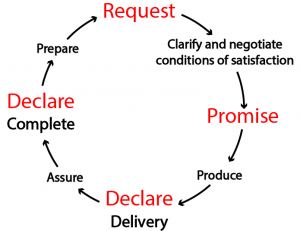This post first appeared in the Huffington Post Business section on 03/02/ 2015
When we think of work culture, what do we mean? Often what we mean is the mood of the place. And there are many moods we are all familiar with that range from excitement, enthusiasm, curiosity, openness, honesty, and partnership to competitive, argumentative, overbearing, cynical, withdrawn, and punitive, to name a few. And how is the mood displayed? Through talking, i.e. how people speak with each other. The tone of voice, the specific words we use, the energy, and even the structure of the dialog are palpable manifestations of work culture. Respect and empowerment are expressed in conversations between work colleagues. Drop into any meeting, listen to how people speak with each other, and you will have an immediate sense of the culture of the organization. How work colleagues speak to each other, what words they use, what mood prevails, and the structure of the dialog have more to do with achieving reliable outcomes than all other factors.
How work colleagues speak with each other is not only evidence of the culture; changing the dialog may also be the biggest lever for changing the culture.
What people say and what they withhold matters. Language trumps control. How the communication is initiated and conducted is often more important than what is communicated. An organization is a network of person-to-person work conversations during which information and energy is exchanged. Like cells in your body, the quality of these “work-atoms” determines the effectiveness of the whole. Attending to and influencing work conversations can help transform culture and improve collaboration.
What’s most interesting to me is that while our dialog is a reflection of all the soft stuff like trust, openness, honesty, engagement, motivation, transparency, confidence, and respect; dialog can also be viewed as a “technology” in the sense that it can be structured, measured, and guided through specific practices. One can readily observe and monitor what dialog is occurring and, in turn, what culture is being expressed and reinforced. Interventions to improve culture by changing the dialog can, therefore, be quite specific, not just platitudes like “we need more trust”.
Managers may spend 80% of their time in conversation, and making those conversations effective is by no means simple. Rather than thinking of conversations as trivial everyday acts, conversations should be thought of as a sophisticated technology for getting things done. The starting point is the recognition that conversation is not just about sharing information. A big part of conversation is about making commitments. You ask me to do something by some date. I reply that I will do it. That kind of promise is the key to control and coordination.
One specific intervention is to use language with more precision. One example would be introducing the distinction between an assertion and an assessment. An assertion is a statement of a fact or belief. An assessment is a personal judgment or opinion. An assessment can either be grounded (i.e., backed up with some evidence) or ungrounded (i.e., just a personal hunch). Another example is to notice that a request is very different from an assignment or a complaint and that an explicit promise from a performer to deliver something by a certain date actually changes the state of things. Making our utterances more precise is a great start to improving work relationships.
Another intervention involves paying attention to the structure of work conversations. Over the last 50 years social scientists and linguists have developed, for example, a precise model for what Dr. Fernando Flores called a “conversation for action” that has four stages. In the first stage the team leader/manager/customer makes a request of a specific performer and the two parties begin the negotiation stage. Once they reach agreement, the conversation moves to the delivery stage. When the performer delivers they enter the acknowledgement/assessment stage where the requester declares whether they are satisfied and completes the conversation. Tracking conversations around this closed loop can be a big boost to better accountability and more on-time deliveries.

Language is both the expression of culture and the lever for changing culture. The “technology of conversations” is a new domain that HR practitioners should become involved with. Organization consultants bring special sensibilities and tools for exposing, exploring, and enhancing work conversations.

